
Creating collage in Lightroom is easier than you might think, especially when you have the right templates. As an expert photographer, I find that lightroom collage adds a unique touch to articles, websites, and social media posts. The key to success understands the framework behind collage templates, which can seem tricky at first but become second nature with a bit of practice. In this guide, I’ll walk you through the basics so you can start crafting your own Lightroom collage templates with confidence.
Table of Contents
The Value of a Lightroom Collage Template
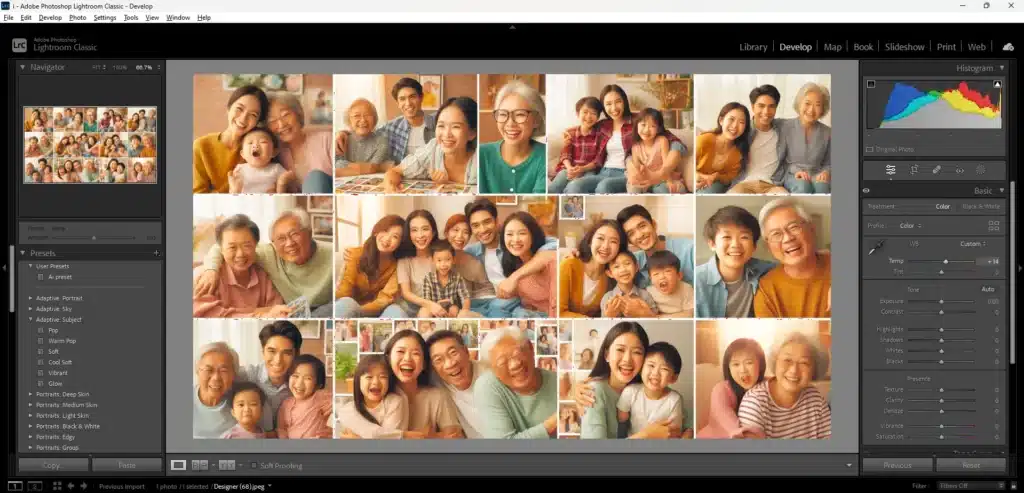
Creating collages in Lightroom offers a multitude of benefits, both for casual photographers and professional designers. By understanding the value that Lightroom collages bring, you can better leverage this tool to enhance your photography and creative projects.
Enhanced Storytelling through Visual Layouts
One of the primary benefits of using Lightroom to create collages is the ability to tell a story through a sequence of images. A collage allows you to present multiple photos in a single frame, offering a more comprehensive narrative than a single image could. This is particularly useful for:
- Wedding photographers who want to present the key moments of a ceremony.
- Travel bloggers looking to showcase a series of landscapes or cultural highlights.
- Family albums where you want to capture different emotions and moments in one place.
By arranging all the images thoughtfully within a collage, you can guide the viewer’s eye across all the photos, creating a more impactful and meaningful visual experience.
Efficiency in Sharing and Presentation
Make a collage in Lightroom simplifies the process of sharing multiple images. Instead of uploading several files, you can share one JPEG format that encapsulates your entire photo set. This is especially beneficial for:
- Social media posts, where you need to capture attention quickly.
- Blog posts, where space might be limited, but you still want to showcase multiple photos.
- Client presentations, allowing you to present ideas more cohesively.
The print module makes it easy to export these complex collages in various formats, ensuring they are ready for both online sharing and high-quality printing.
Creative Control with Custom Lightroom Collage Templates
Lightroom collage templates give you the flexibility to customize the layout according to your creative needs. While Lightroom provides default templates, you can also create your own templates to fit specific project requirements. This customization is crucial for:
- Brand consistency: Ensuring your collages reflect your brand’s aesthetic, especially when used in marketing materials.
- Personal projects: Tailoring the design to match the theme or mood of a photo series.
- Professional use: Meeting the specific dimensions and layouts required by clients or for publication.
Custom file dimensions and the ability to save these templates for future use means you can maintain a consistent style across multiple projects.
Versatility across Various Uses
Whether you’re using collages for personal or professional purposes, Lightroom’s collage feature provides versatility in how you present your photo in lightroom. Some key uses include:
- Graphic design projects: Creating mood boards or concept presentations.
- Marketing materials: Designing flyers, brochures, or online ads.
- Photo albums: Producing digital or printed photo books with a professional finish.
The flexibility of collage templates in Lightroom also means you can adjust them for different output formats, from web use to high-resolution prints.
Integration with Other Adobe Tools
Lightroom’s seamless integration with other Adobe products, like adobe Photoshop, enhances the value of making collages. You can start a project in Lightroom and then move an image in Photoshop for more complex edits, such as adding text or advanced effects. This workflow is particularly useful for:
- Designers who need to combine multiple elements from different tools.
- Photographers looking to add a creative touch that goes beyond basic editing.
- Marketers who want to produce polished, professional-grade visuals.
The ability to export collages as TIFF files or high-quality JPEGs ensures that your final product maintains the highest possible quality for any application.
Essential Tools to Design Stunning Collages in Lightroom
| Feature | Description | Primary Use | Tips for Optimization |
|---|---|---|---|
| Print Module | A versatile tool that allows you to create custom layouts for collages. | Designing and exporting collages | Use the Custom Package layout for maximum flexibility in arranging images. |
| Virtual Copies | Creates multiple versions of an image without duplicating the original file. | Experimenting with different edits in a collage | Use virtual copies to try out different styles within the same collage. |
| Photo Border | Adds borders around individual images within the collage. | Visual separation between images | Adjust border thickness to add a professional touch or enhance focus. |
| Lens Blur | An AI-powered tool that adds a soft, dreamy blur effect to images. | Highlighting specific areas of the collage | Apply selectively to draw attention to focal points within your collage. |
| Export Settings (JPEG Quality) | Controls the quality and compression level when exporting the collage. | Ensuring high-quality output for print or digital | Set JPEG Quality to 100% for the best image clarity when exporting. |
| Template Browser | Allows saving of custom collage layouts for future use. | Efficiency in future projects | Save frequently used layouts in User Templates for quick access. |
Print Module: The Foundation for Collage Creation
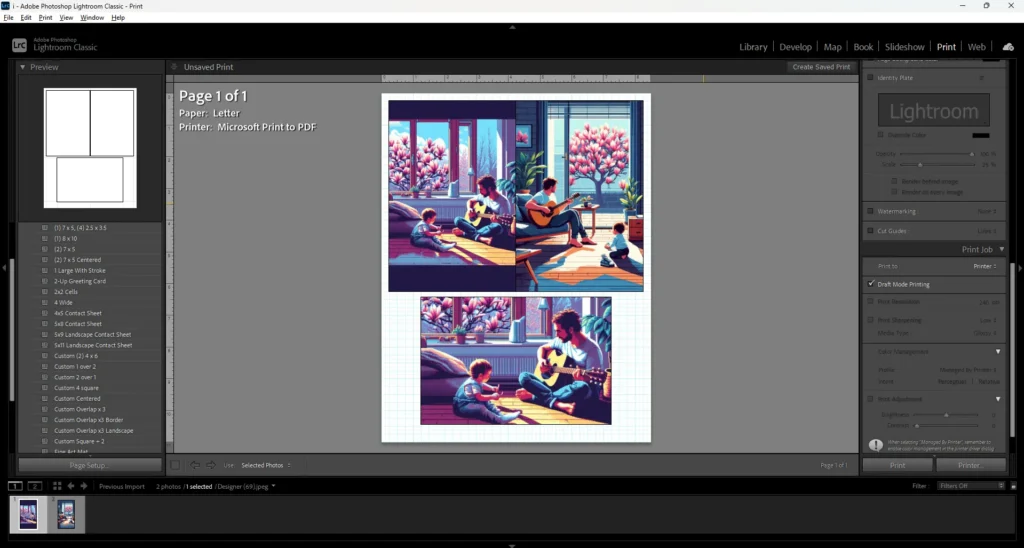
The Print Module is the primary tool for creating collages. It offers extensive customization options, allowing you to design layouts that match your creative vision. Here’s how to create the most of it:
- Custom Package Layout: Start by selecting the "Custom Package" layout. This option gives you the freedom to place and resize image cells anywhere on the page, enabling personalized designs tailored to your needs.
- Page Setup and Dimensions: Before diving into design, set your custom file dimensions. For web use, a common resolution is 100 ppi, which ensures your collage will look sharp on most screens. You can adjust these settings depending on your intended output, whether it’s for print or digital use.
- File Export Settings: Ensure the highest quality by setting JPEG quality to 100% and enabling print sharpening. These settings preserve image clarity, especially important when sharing your collage online or printing.
Virtual Copies: Experiment Without Limits
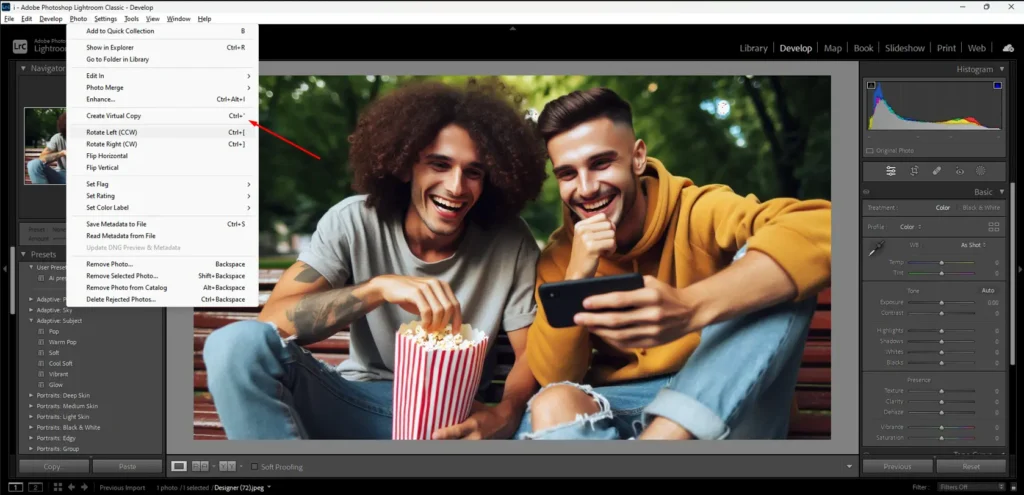
Virtual copies are an essential feature in Lightroom that allows you to create multiple versions of your images without duplicating files. This tool is perfect for experimenting with different edits and layouts within your collage. You can create a virtual copy for each image, try out various looks, and decide which version fits best in your collage without affecting the original photo.
- Cells Panel: Precision Layouts for Professional Results
The Cells Panel in Lightroom is where you fine-tune the layout of your collage:
- Add and Arrange Cells: Start by adding cells (containers for your images) to your layout. You can resize and reposition these cells to fit your design needs. For instance, you might want a large landscape photos at the top with smaller portrait images beneath it.
- Aspect Ratio and Grid Snap: Maintain the aspect ratio of your images by locking the photo aspect ratio during resizing. This ensures that your images don’t get distorted when you adjust the size of the cells. Using the photo grid in Lightroom feature helps align your images perfectly, giving your collage a clean and professional look.
Lens Blur and Generative Remove: Adding Artistic Touches
The last update to Lightroom introduced powerful new tools like Lens Blur and Generative Remove:
- Lens Blur: Use this AI-powered tool to add soft, dreamy blur effects to your collage, focusing the viewer's attention on specific parts of your image. This can be particularly effective in creating a sense of depth in your collage.
- Generative Remove: Clean up your images by removing unwanted elements with this advanced tool. It’s especially useful for ensuring that the focus remains on the key subjects of your collage, enhancing overall visual appeal.
Watermarking and Identity Plate: Brand Your Collages
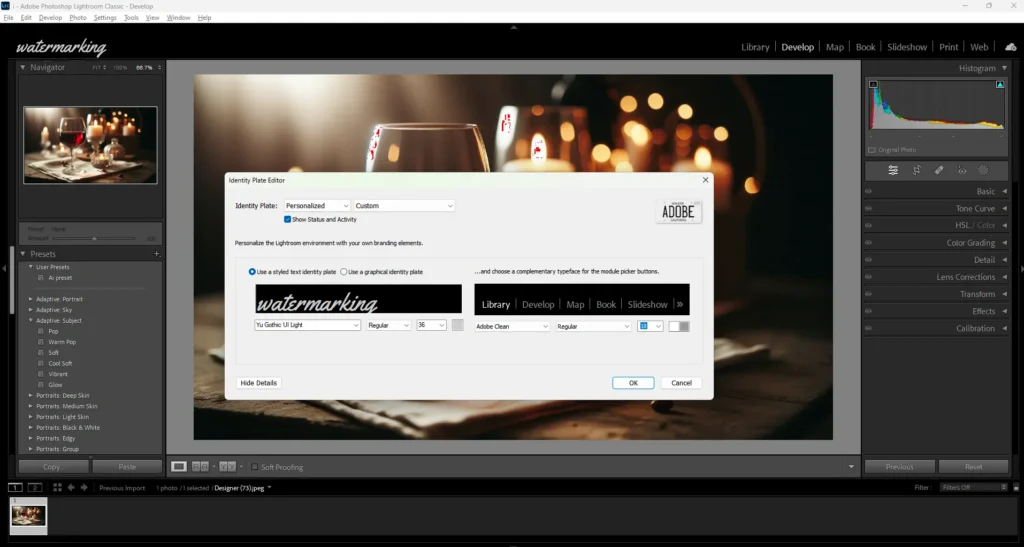
If you’re sharing your collages online or with clients, adding a watermark or identity plate is a good practice. Adobe Lightroom allows you to:
- Add Watermarks: Easily apply a watermark to each image within the collage. This feature helps protect your work and ensures that your brand is visible on all photos.
- Identity Plate: Place your logo or brand name on the collage using the identity plate option. This is customizable and can be positioned anywhere on the collage, helping to maintain a professional look while promoting your brand.
By mastering these essential tools in Lightroom, you can create collages that are both visually appealing and professionally polished. From customizing layouts in the Print Module to adding artistic effects with Lens Blur, these features offer endless possibilities for creativity. Whether you’re designing for personal projects or professional presentations, these tools ensure your collages stand out.
Setting Up Lightroom Collage Templates
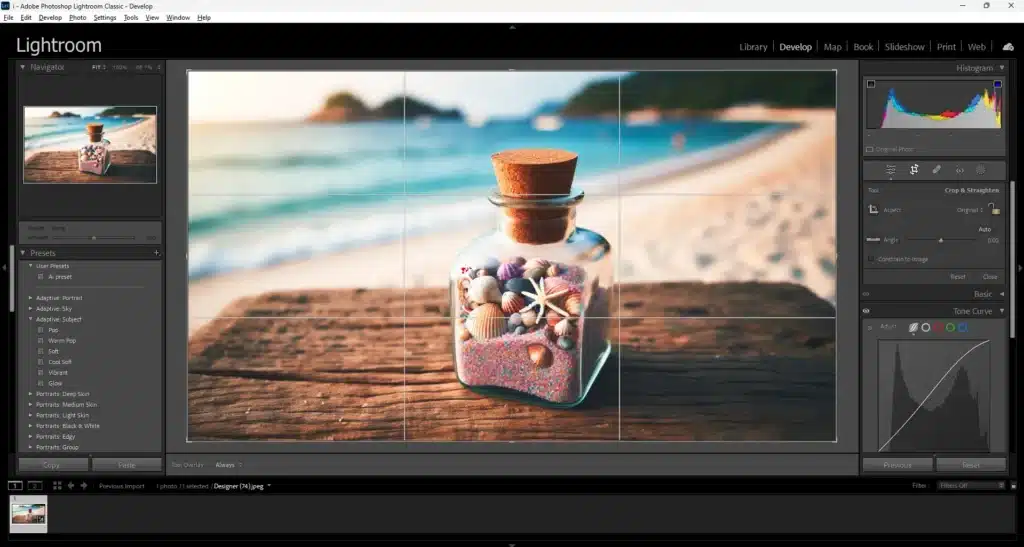
Creating Lightroom Collage Template is a crucial skill for photographers and designers who want to streamline their workflow and produce consistent, high-quality collages. By setting up customized templates, you can save time and ensure that your designs are always aligned with your project needs.
Starting with the Print Module
The Print Module in Lightroom Classic is the foundation for creating collage templates. This module is primarily designed for printing, but it also provides a robust environment for designing and saving collage templates for both print and digital use. Here’s how to get started:
- Select the Layout Style: Begin by selecting the Custom Package layout style. This option gives you the flexibility to place images in any configuration you like, rather than being restricted to a single image layout.
- Set Document Dimensions: Depending on your output needs, set your document dimensions. For web images, a common resolution is 100 ppi, which ensures that your collage will look sharp on most screens. If you're unsure of the final dimensions, it's better to start larger, you can always scale down later without losing quality.
Adding and Arranging Image Cells
Once your document is set up, the next step is to add and arrange the image cells where your photos will be placed:
- Add Cells: Use the Cells Panel to add cells to your layout. These cells act as placeholders for your images. You can resize and reposition them to match your design needs. For example, you might want a large landscape image across the top and two smaller portrait images below.
- Maintain Aspect Ratio: Ensure that your images maintain their aspect ratios when resized by locking the aspect ratio in the Cells Panel. This prevents any distortion and keeps your images looking professional.
Customizing and Saving the Template
Customizing your collage template is essential to ensure it meets your specific requirements:
- Customize Borders and Guides: You can add a photo border around each image cell to create visual separation between images. Adjust the thickness and color of these borders to match your overall design aesthetic.
- Save the Template: Once you’re satisfied with the layout, save your own template by clicking the plus sign at the top of the Template Browser Panel. Name your template and select the folder where you want to save it, such as "User Templates," so it’s easily accessible for future projects.
Utilizing Pre-made Templates
If you’re looking for a quicker solution, pre-made collage template can be a great option. These templates are designed to save time and provide consistency:
- Download and Install: There are many resources where you can download pre-made templates that are compatible with Lightroom Classic. These lightroom templates often come in various aspect ratios and are optimized for different uses, such as social media, printing, or scrapbooking.
- Customizing Pre-made Templates: Even with pre-made templates, you can still customize aspects like border size, color, and layout to better fit your project needs. This combination of pre-made and custom templates ensures flexibility and efficiency in your workflow.
Setting up Lightroom collage template allows you to streamline your workflow and ensure consistency across your projects. Whether you’re creating your own templates from scratch or utilizing pre-made ones, the Print Module offers the tools and flexibility you need to produce stunning collages with ease. By mastering these steps, you can save time and focus more on the creative aspects of your work.
FAQ about Lightroom Collage

How to combine 3 photos into one in Lightroom?
To combine 3 photos into one in Lightroom, you should use the Print Module. Start by selecting the “Custom Package” layout style. Then, add three cells (placeholders) to the layout and drag each of your photos from the Filmstrip into these cells. Arrange them as desired, ensuring that the aspect ratio is locked for each image to prevent distortion. Once satisfied with the layout, export the collage as a JPEG file.
Can you do a collage in Lightroom?
Yes, you can create a collage in Lightroom. The process involves utilizing the Print Module where you can arrange multiple photos into a custom layout using the “Custom Package” option. This allows you to create personalized other collages with various image placements and export them as high-quality JPEG files.
How do I put two photos side by side in Lightroom?
To place two photos side by side in Lightroom, you can again use the Print Module with the “Custom Package” layout. Add two cells side by side on the canvas and drag your photos from the Filmstrip into these cells. Adjust the size and spacing as needed, then export the collage as a JPEG file using the Print Job panel. You can also experiment with adding borders or background colors to enhance the visual appeal. For even more customization, consider saving your layout as a template for future use.
How do I stitch photos together in Lightroom?
Lightroom does not have a dedicated photo stitching feature like Photoshop’s Panorama tool. However, you can manually place side by side picture or in a grid layout using the Print Module. For more advanced stitching, such as creating a seamless panorama, it’s recommended for photoshop action or another dedicated tool. Lightroom’s flexibility in arranging images allows for creative collages in Photoshop. Additionally, using Virtual Copies in Lightroom (lightroom shortcuts: Ctrl + Apostrophe on Windows or Cmd + Apostrophe on Mac) can help experiment with different edits before finalizing your layout.
Conclusion: Lightroom Collage
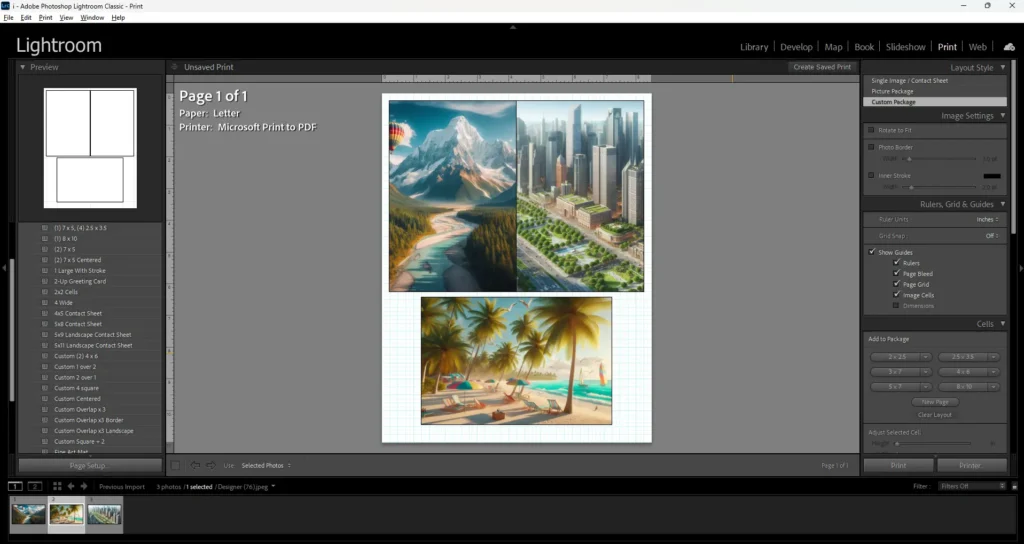
Creating stunning collages in Lightroom is key to my workflow. I remember using the Print Module to arrange travel photos, it turned into a beautifully organized visual narrative. Lightroom’s custom templates make it my go-to. Explore our Photoshop course and Lightroom course to master these tools!
Have a nice photoshoot!
Read more about: Photo Editing with Lightroom and Photoshop















